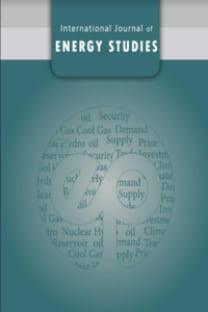Investigation and Comparision of Thermal Energy Storage Methods Used in Food Production
Food products must be cooled to maintain product quality in the food industry and to extend shelf life by slowing or stopping the enzymatic activities of food products. Different refrigerants are used in cooling systems to meet cooling loads. The refrigerants in the Hydrofloroclorocarbon (HCFC and clorofluorocarbon (CFC) group used in the cooling system can be caused significant damage to the environment. However, cooling systems which need to work long hours for the preservation of food products cause high energy costs. Efficient use of energy reduces environmental problems and its effects on energy costs are also important.When the cooling loads in food production are high, thermal energy storage is very important in energy systems to meet instantaneous energy loads. In this study, thermal energy storage models in cooling processes used in food production were investigated. The technology used in thermal energy storage models was compared in terms of efficiency, environmental effects, coefficient of performance and risks. By investigating the effects of thermal energy storage methods for cooling purposes in food production costs, appropriate thermal energy storage technologies-systems have been proposed. By explaining the importance of energy storage in the perspective of energy and environment, food producers were provided with practical information about thermal energy ice storage systems.
Keywords:
Food production, ice storage, thermal energy storage, cooling,
___
- [1] Azarifar M., Sömek S.K., Dönmezer N. ‘’Faz Değiştirme ile Isı Depolamada Kullanılan Parafin-Grafit, Parafin- Kanatçık ve Saf Parafinli Yapıların Performans Analizi’’, Çukurova Üniversitesi Mühendislik Mimarlık Fakültesi Dergisi, 32(3), ss. 155-163, Eylül 2017.
- [2] Koşan M. ve Aktaş M. “Faz değiştiren malzemelerle termal enerji depolayan bir ısı değiştiricisinin sayısal analizi”, Politeknik Dergisi, 21(2): 403-409, (2018).
- [3] Dincer I. ‘’On thermal energy storage systems and applications in buildings’’, Energy and Buildings 34 , 377–388, (2002).
- [4] Ice-based thermal energy storage used to help cool India's milk supply, http://www.calmac.com/energy-storage-article-ice-based-thermal-energy-storage-used-to-help-cool-indias-milk-supply Erişim tarihi: 22.05.2020
- [5] Kauffeld M., Wang M.J., Goldstein V.,. Kasza K.E. ‘’Ice slurry applications’’, International Journal of Refrigeration 33,1494-1505, (2010).
- [6] P. R. Kumar , S. R. Balaji , D. Mohan Lal & A. Kalanidhi .‘’Energy optimisation studies in a dairy industry ice bank tank’’, International Journal of Ambient Energy, 22:4, 181-188, (2001).
- [7] Elektrik tarifeleri, https://www.epdk.org.tr/Detay/Icerik/3-23448/01012020-tarihinden-itibaren-gecerli-elektrik-t#, EPDK ,Erişim Tarihi: 22.05.2020
- [8] Fang G, Tang F, Cao L. ‘’Dynamic characteristics of cool thermal energy storage systems-a review’’. International Journal Green Energy ;13:1-13, (2016).
- [9] Nelson JEB, Balakrishnan AR, Murthy SS. ‘’Parametric studies on thermally stratified chilled water storage systems’’, Appl Thermal Engineering, (1999).
- [10] Ghamrawi A., Haykal C., Al-Chaaban F. ‘’Comparative Study on Photovoltaic and Thermal Solar Energy Concentrators’’, The International Conference on Electrical and Electronics Engineering, Clean Energy and Green Computing , (2013). [11] Alva G., Lin Y., Fang G. ‘’An overview of thermal energy storage systems’’, Energy 144,341-378, (2018). [12] Navarro AL, Taronger JB, Jaime BT, Galvan IM, Corberan JM, Matias JCE, et al. ‘’Experimental investigation of the temperatures and performance of a commercial ice-storage tank’’, International Journal of Refrigeration, (2013).
- [13] Erek A, Dincer I. ‘’Numerical heat transfer analysis of encapsulated ice thermal energy storage system with variable heat transfer coefficient in downstream’’, International Journal Of Heat Mass Transfer 52-851-9, (2009).
- [14] Bedecarrats J.P., Castaing-Lasvignottes J., Strub F., Dumas J.P. ‘’Study of a phase change energy storage using spherical capsules. Part I: Experimental results’’, Energy Conversion and Management 50,2527-2536, (2009).
- [15] Ott V.J. ‘’Cryogel Presentation-Ice ball Thermal Energy Storage Systems’’, Cryogel, San Diego, (2011).
- [16] Matsumoto K, Namiki Y, Okada M, Kawagoe T, Nakagawa S, Kang C. ‘’Continuous ice slurry formation using a functional fluid for ice storage’’, International Journal of Refrigerant , 27:73-81. (2004).
- [17] Gladis S.P. ‘’Ice slurry thermal energy storage for cheese process cooling’’, American Society of Heating, Refrigeration, and Air-Conditioning Engineers, Inc. from ASHRAE Transactions (1997).
- [18] Lin L., Elston L.J., Harris R. ‘’Ice Slurry Thermal Energy Storage System’’, 10th AIAA/ASME Joint Thermophysics and Heat Transfer Conference, Chicago, (2010).
- Yayın Aralığı: Yılda 4 Sayı
- Başlangıç: 2016
- Yayıncı: Türkiye Enerji Stratejileri ve Politikaları Araştırma Merkezi (TESPAM)
